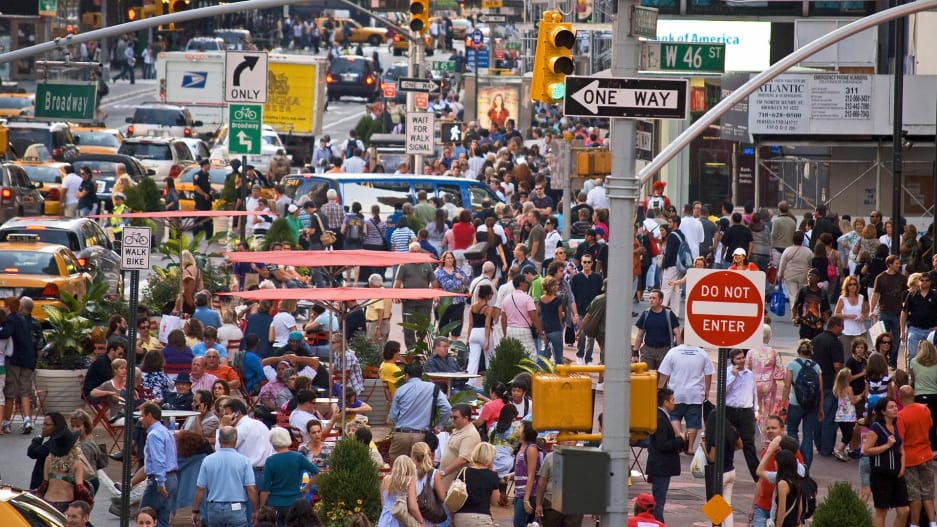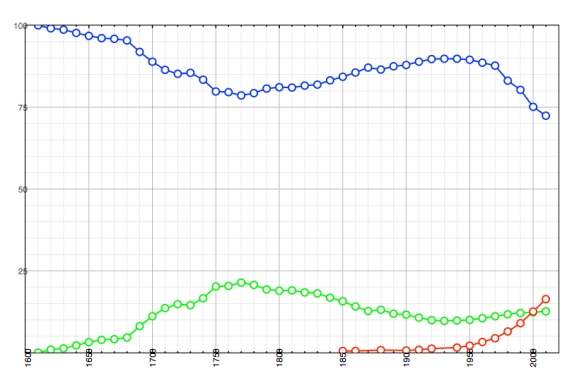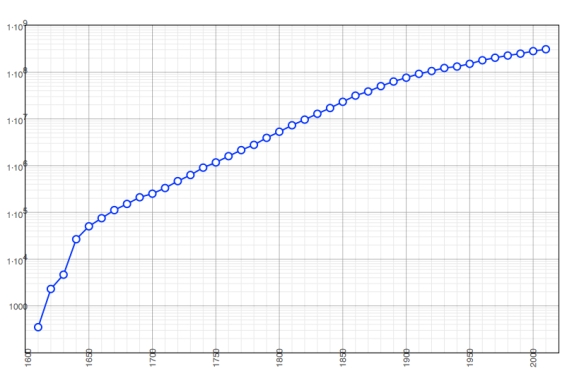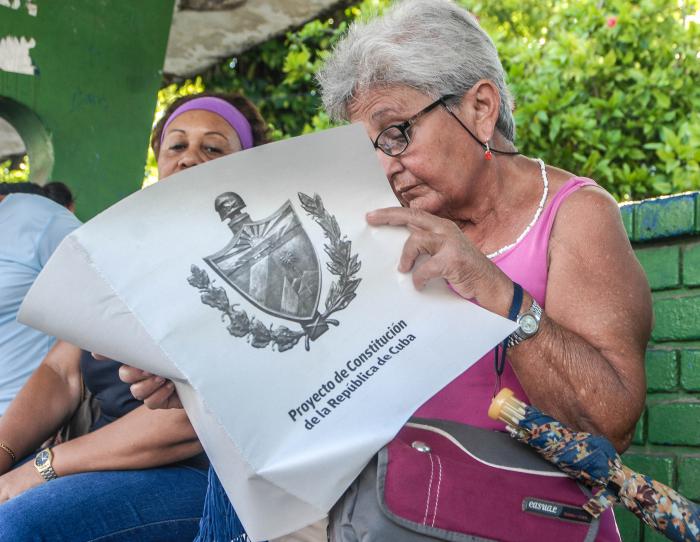By Manuel Garcia, Jr., manuelgarciajr, September 26, 2018
 |
| New York City |
The population of English colonists on the eastern shores of what would eventually become the United States of America numbered 350 in 1610. Their descendants, along with those of the subsequent imported Black slaves, many immigrants (legal and illegal), and later remnants of the Native American population whose ancestors had populated this continent since as early as 14,000 years ago, reached a cumulative population of 308,745,538 individuals in 2010, within the political boundaries of the U.S.A.
This essay is a very general and simplified overview of how the population within the territory of the United States has grown over the 400 years between 1610 and 2010. While there is a very wide spectrum of “races” and ethnicities in the U.S.A., this essay will focus on only three groups: White people, Black people and Latino (a.k.a. Hispanic) people. Both White and Black people are thought of as two racial groups; while Hispanic people have Spanish as their original language, and their cultures are based on it, and they can be of any race: White, Black, Red, Yellow, and any mix of these. The summation of the White, Black and Hispanic populations in the U.S. makes up nearly the total US population. Asian and Pacific Islander people make up only 4.9% of the US population (in 2010); and American Indian, Eskimo and Aleut people make up only 0.9% of the US population (in 2010).
An aside on “races”: Based on genetics there is only one race of humans, but the concept of human races — popularly treated as species! — based on skin color, facial and physiological features, is still too widespread and embedded in popular culture to be dispensed with here. Also, race is tabulated in U.S. Census data, upon which this essay is based.
What I am interested to learn is if I can understand the politics of a period from the demographics of that time.
The first pair of charts (quantitatively identical, just with different data-set color schemes, for ease of viewing) show fractional populations as percents of the total US population, from 1610 to 2010. The top curve is for White people, the longer lower curve is for Black people, and the shorter lower curve, which begins at 1850, is for Latino (Hispanic) people.
This census data is not perfect. The United States Census has enumerated Whites and Blacks since 1790. Asians and Native Americans have been enumerated since 1860, though all Native Americans were not enumerated until 1890. A category enumerated since 1950 is “some other race,” and a category enumerated since 2000 is “two or more races.” Hispanics have been enumerated since 1940, with the exceptions of 1950 and 1960, but some estimates for the Hispanic population were made for certain years before 1940 as well as for 1950 and 1960.
The recorded percentages over time of the US population made up of Asian and Pacific Islander people are: 0 for 1610-1850; under 1% for 1860-1970; 1.5% for 1980; 2.9% for 1990; 3.8% for 2000; 4.9% for 2010.
The number of Native Americans in 1492 within the territory of the present day United States probably numbered 5 million people. By 1900 this population had dwindled to 237,196 (its minimum). It grew subsequently, reaching 1,420,400 in 1980, and 2,932,248 in 2010.
The growth of the total US population — as recorded by the imperfect census data — is shown in this next pair of charts.
The first chart of this second pair of graphics is best for visualizing the grow of population above 5 million people, after 1800. The recorded population grew from 350 in 1610 to about 5 million in 1800. The second chart of this pair of graphics is a logarithmic (linear-log) representation of the data, and makes it possible to see the quantitative trend, especially prior to 1800.
Returning to the fractional population charts, notice the following features:
1610-1770
The fractional population of Whites dropped from 100% in 1610, to under 80% in 1770; with a corresponding rise in the fractional population of Blacks from 0% (a relatively small number in actuality) in 1610, to over 20% in 1770. In the Colonial America of 1770, 1 out of very 5 people was Black (remember, Native Americans were not counted). This (20%) is the maximum that the fractional population of Blacks ever achieved in American history (but of course, the absolute Black population has grown throughout US history). This growth in Black population was a result of the importation of enslaved Blacks from Africa. The total Colonial American population during this period grew from 350 to 2,148,076.
1770-1850
The fractional population of Whites rose from its local minimum of less than 80% in 1770, to almost 85% in 1850. The fractional Black population dropped from its local maximum of over 20% in 1770, to about 16% in 1850. A law banning the importation of slaves into the United States took effect in 1808, but slavery itself was not outlawed. Blacks were born into slavery if their parents were enslaved, and the absolute population of Blacks in the U.S. grew. This period of 1770 to 1850 corresponds to the Industrial Revolution, which was the transition to new manufacturing processes in the period from about 1760 to sometime between 1820 and 1840. This transition included going from hand production methods to machines, new chemical manufacturing and iron production processes, the increasing use of steam power, the development of machine tools and the rise of the factory system. Immigrants from Europe added to the White population in the U.S., for example Irish people seeking escape from their Great Famine of 1845 to 1852. The total American population during this period grew from 2,148,076 to 23,191,876.
1850-1900
The recorded (estimated) percentage of the US population made up of Hispanic people was under 0.8% between 1850 and 1900. In 1845, the United States annexed the “Republic of Texas” (Mexican territory occupied by “illegal immigrant” American slave owners seeking to expand the slave plantation system of the Southern U.S., westward). Mexico’s defeat in the subsequent Mexican-American War of 1846-1848, resulted in the loss of one-third of its territory to the U.S. That new US territory is the present day American states of Texas, New Mexico, Colorado, Arizona, Utah, Nevada and California.
The fractional population of Whites rose from nearly 85% in 1850, to about 87% in 1900; while the fractional population of Blacks dropped from about 16% in 1850, to about 13% in 1900. This half-century period encompassed the Civil War, the Indian Wars in the American West, and the Spanish-American War, when the United States became an overseas empire. The total American population during this period grew from 23,191,876 to 75,994,575.
1900-1930
Between 1900 and 1930, the fractional White population rose from 87% to 90%, while the fractional Black population dropped from 13% to under 10%. This thirty year span included the latter Gilded Age, World War I, the Roaring Twenties, and the Crash of 1929, which was the beginning of the Great Depression. The total American population during this period grew from 75,994,575 to 122,775,046.
1930-1940
The years 1930 to 1940 spanned most of the Great Depression (which actually occurred from 1929 to 1942), and are a local maximum of fractional White population (~90%), and a local minimum of fractional Black population (~9%). The fractional Hispanic population during 1930 to 1940 rose from about 1.3% to 1.5%. The total American population during this period grew from 122,775,046 to 131,669,275.
1930-1950
Between 1930 and 1950, the fractional White population remained at close to 90%, while the fractional Black population remained at close to 10%. This twenty year period included the Great Depression, World War II, and the brief Cold War period just after World War II and just prior to the outbreak of the Korean War in 1950. The fractional population of Hispanics rose from about 1.3% to 2.1% during 1930 to 1950. The total American population during this period grew from 122,775,046 to 150,697,361.
1950-1970
Between 1950 and 1970, the fractional White population dropped from its highest proportion since 1700 (about 90%) to nearly 88%. The fractional Black population rose from 10% to 11%; and the fractional Hispanic population grew at an accelerating pace — more than doubling — from 2.1% to over 4.4%. The rapid increase in US Latino population was a result of their higher fertility, and increased immigration from Mexico, Central and South America, and the Caribbean.
The people on the island of Puerto Rico, captured during the Spanish-American War of 1898, were given US citizenship in 1917, but not the right to vote in US national elections, nor were Puerto Rico’s elected representatives allowed to vote in the U.S. Congress (to this day). But, that extension of US citizenship for Puerto Rico came just in the nick of time for the Wilson Administration to draft men from Puerto Rico to fight (and presumably some die) in World War I, and similarly in the subsequent wars of the United States. Puerto Ricans who want to vote in US elections have to migrate to the US mainland and settle there, which many did during the 1940s and 1950s, primarily to seek better economic opportunities. The musical “West Side Story” is an artistic artifact inspired by this wave of immigration from Puerto Rico to the US mainland.
The twenty year span of 1950 to 1970 included: most of the postwar boom (occurring primarily from 1948 to 1971), which encompassed the last two years of the Truman Administration, and the Eisenhower, Kennedy and Johnson Administrations, and the first two years of the Nixon Administration, as well as the Vietnam War up through the time of the American invasion of Cambodia, ordered by the Nixon-Kissinger Administration. The total American population grew from 150,697,361 in 1950, to 203,210,158 in 1970.
1970-2010
The total American population grew from 203,210,158 in 1970, to 308,745,538 in 2010.
During the 40 years between 1970 and 2010, the fractional White population dropped significantly from 88% to 72%. The fractional Black population rose modestly from 11% to 12.6%; and the fractional Hispanic population zoomed from 4.4% to 16.3%. In the year 2000, the fractional Black and fractional Hispanic populations were essentially equal (12.3% and 12.5%, respectively), and subsequently the fractional Hispanic population became larger, and continued growing faster.
The rapid rise of the fractional Hispanic population subsequent to 1950, and especially since 1970, is responsible for the accelerating drop in the fractional White population (since the fractional Black population has changed little, and other fractional populations, as for Asians, are still relatively small).
The increase of the Hispanic population beyond that of the Black population after 2000, along with the corresponding drop in the fractional White population, has fueled the racial tensions expressed today as the Trump Administration: widespread Black resentment of Latinos (“Mexicans”), and the overt exercise of political power by White Supremacy: anti-immigrant and deportation policies against “illegal” Mexicans and people from Muslim-dominant countries, as well as voter suppression efforts aimed at Blacks and poorer Hispanics (many ethnically Mexican and Central American).
Trumpism is the combination of fear of demographic dilution — held by previously dominant racial-ethnic sub-populations; and of insatiably desperate exclusionary avarice seeking climax before our Pompeii-like climapocalyptic termination — held by the traditional, dominant and uppermost classes of American wealth.
Most of the undocumented (“illegal”) Central American immigrants to the United States were and are actually refugees from countries whose economies have been withered by US corporate vampirism backed by both direct and indirect US military interventions propping up corrupt and viciously cruel oligarchic client regimes. This predatory US imperialism “south of the border” stretches back to the Mexican-American War of 1846-1848, and includes many US Marine invasions and occupations prior to World War II, as famously condemned by General Smedley Butler (who was awarded several Medals of Honor for his heroism during such actions, in his earlier years when he commanded troops in them).
During World War II, President Franklin Roosevelt instituted the “Good Neighbor Policy,” which amounted to the U.S. being nice to Latin America and buying its export products at good prices for the producers (for example buying the entire Cuban sugar output during the war years), so as to induce the countries of the Caribbean and Central and South America to remain neutral in that war, instead of cashing in by provisioning Germany, and allowing its submarines to harbor safely in Latin American ports, and thus be able to hunt for Allied (i.e., American) war supply ships close to US shores.
After World War II, the Good Neighbor Policy disappeared and it was back to the Monroe Doctrine modus operandi. And, Central American peasants fleeing economic starvation and political murder would go north (to this day). A particularly bad period in this regard was during the Nicaraguan Revolution (1962-1990), and during the Reagan Administration (1981-1988), which massively, overtly and surreptitiously prosecuted its proxy Contra War in Nicaragua, in support of the remnant army and police forces of the Somoza dictatorship, which had been deposed by Nicaraguan socialists during 1978-1979.
The Reagan Administration also carried on similar proxy wars in Guatemala and El Salvador. The neofascist forces the Reagan Administration backed and supplied were responsible for many excessively cruel and massively bloody deeds, which many people — including me — considered genocidal. After 1990, the Central American wars tapered off, but the fundamental struggle — of a peasantry seeking political freedom, economic control of their lives, social justice, and physical security from arbitrary exploitation, torture and murder by the death squads and militarized police forces employed by corrupt oligarchic client regimes — still continues in some Central American countries.
And so, streams of impoverished displaced living victims of American profiteering in Central America go north, hoping to find their personal salvations in the United States. Those that make it (legally or illegally) add to the Latino Population Tsunami that is altering the demographic layering of the US population.
How will our changing demographics change our future politics? Good question.









